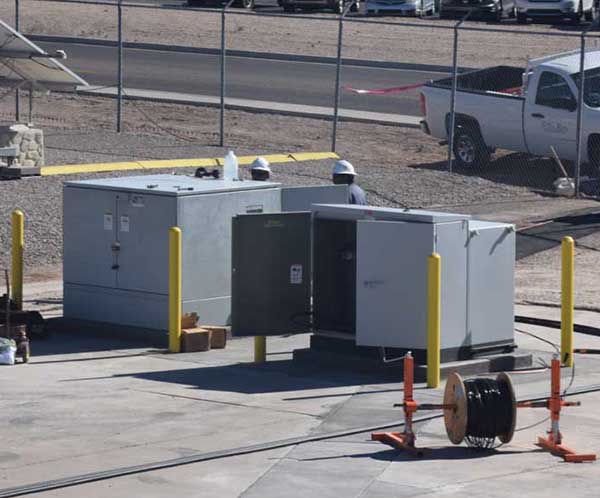Sandia will soon become a bigger player in solar energy research with the installation of a new 500 kW transformer at the Photovoltaic Systems Evaluation Laboratory (PSEL).
This will increase the amount of photovoltaic (PV) energy generated at PSEL to the equivalent of up to 100 large residential PV systems.
“Currently, we have more PV deployment than our local grid interconnection can handle,” says PSEL site lead Bruce King. “Increasing our grid interconnection capacity has been a goal of mine for many years, and partnering with Facilities was a natural avenue to make it happen. The new transformer will allow us to grow to 750 kW total capacity and will drive expansion opportunities in the future.”

The transformer will lead to additional PV research and serve the dual purpose of enabling the deployment of more onsite renewable energy at Sandia. It also will allow PSEL to bring in more research and development opportunities for the Labs. According to Bruce, these additional opportunities will enable Sandia to increase its ability to study and test PV systems beyond the panels themselves.
“To study full-size systems, we have to be able to put the energy they generate somewhere,” Bruce says. “What better place than on to the grid where it can be used? This new transformer will allow us to harvest the energy generated while we study new technology designed to boost the efficiency and reliability of PV panels.”
Operating since the late 1970s, PSEL conducts DOE-funded research in photovoltaic energy, performance, and system designs with the goal to develop more sustainable solutions for the nation’s energy infrastructure. The site also provides a dedicated platform for PV manufacturers to validate how well they work under different environmental conditions.
“We look at performance differences and how panels react under different conditions,” Bruce says. “We use this information to develop performance models to better predict system power, to assess new PV module architectures, and to monitor the durability of PV modules.”
The procurement of the transformer was made possible through the collaborative efforts of personnel with PSEL and Facilities and Emergency Management. Facilities provided funding and a spare transformer that allowed PSEL to embark on this initiative. Implementation of these renewable-type projects assists Facilities with meeting DOE requirements related to Leadership in Energy and Environmental Design (LEED) certification — a green building certification system — by generating onsite renewable credits.
“The PSEL transformer upgrade and the 60 kW PV system deployment are part of a broader Sandia initiative to deploy more renewables onsite and modernize our electrical infrastructure,” says photovoltaic and distributed systems manager Abraham Ellis, who championed this project.
Greater investment in solar energy has garnered support from other organizations at Sandia. The High Performance Computing facility installed approximately 60 kW of PVs at PSEL to offset its energy usage as part of their LEED certification.
“Since we couldn’t put solar energy on our building, we felt offsetting was the best way to achieve this,” says Tom Klitsner, senior manager in computing systems and technology integration. “PSEL already had the infrastructure, and we helped invest in the panels and installation.”
Investing in renewable energy sources like solar is an important step toward Sandia’s sustainability goals. The use of renewables such as solar energy is a key part of this process. Future collaborative efforts among different organizations are anticipated to support greater solar energy research at Sandia.
“It illustrates how a partnership between Facilities, R&D groups, and other mission-enabling organizations can address corporate objectives while also enhancing research capabilities. We see the opportunity for more partnerships like this in the future,” Abraham says.
Over the next few years, PSEL will continue expansion opportunities to generate more onsite solar power both for solar R&D research and to modernize Sandia’s energy infrastructure. Thanks to the installation of the new transformer, Sandia is on its way to achieving this objective.